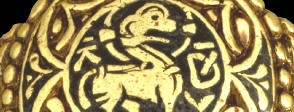After a fact-finding exercise, a practical activity would be a good start to investigating these rings.
Tell students the translated inscriptions on the ring and the dates the rings were made. Ask them to find out about King Æthelwulf and Queen Æthelswith. They should be careful to check the dates as there was more than one King Æthelwulf.
Show front and back images of the rings to the students – see For the classroom - and ask them to look at them very carefully, so that they can create their own replicas. Students could use pencils and paper or embossing foil to make their replicas. Ask them to focus on recreating the shape and size and some of the detail. Students who have attempted to make their copies to scale may have discovered that the rings are too large to wear on bare hands. Why do they think they were made so big?
You can then explore some aspects of the significance of the rings.
Ask students to find the two places the rings were found on a map. Ask students to use the maps in For the classroom to find out how the boundaries within England shifted as the Anglo-Saxon kingdoms changed and the Vikings invaded. Students could make a series of maps to arrange on a timeline. Ask students to identify the find spots of the rings on these maps. Discuss possible reasons why one of the rings was made for the house of Wessex but was not found in Anglo-Saxon territory.
Ask students to investigate why the king of Wessex needed to have loyal friends and a strong army. There are links in For the classroom that will help students find out about the threat of Viking invasion and Anglo-Saxon wars with the Vikings.
The rings were probably given to friends of the house of Wessex to keep them loyal and to show off two things that were important to the royal family; their wealth and their religion. Ask students to design or describe a status symbol that they would give to a friend. Ask them to think about how it reflects themselves and their best qualities; and how they would make the gift attractive to their friend (to keep them onside).
Using the objects in A Bigger Picture, discuss how, although England was divided among different rulers, Anglo-Saxons and Vikings came into contact with each other. Give students an image of the silver disc brooch of Ædwen. Ask them to compare it to the Anglo-Saxon brooch from Beeston Tor and the Viking grave slab from London in For the classroom. They should annotate the brooch of Ædwen, perhaps using one colour for Viking and another for Anglo-Saxon. Can students think of reasons why the brooch shows both Viking and Anglo-Saxon ideas?
Common features of Anglo-Saxon jewellery design include symmetry and the use of plant and animal motifs. Can students identify these on the rings? Ask students to use the British Museum website to find more examples of Anglo-Saxon jewellery - there are links in For the classroom - and compare them with the rings. Students could go on to design their own ring in Anglo-Saxon style, including an inscription, perhaps using the Latin for king and queen and names of other Anglo-Saxon kings.


